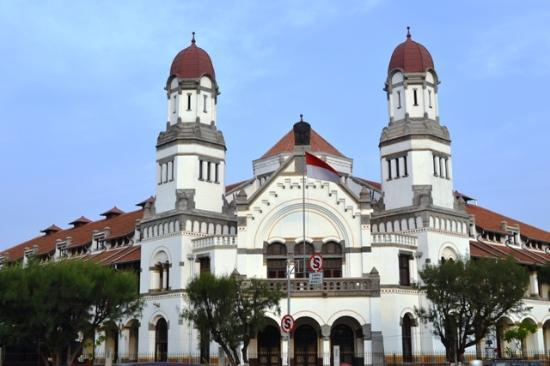
photo of Lawang Sewu, a legend of Semarang in Indonesia
when Horror Yearbook – In the heart of Semarang stands a majestic colonial-era building known as Lawang Sewu. Its elegant architecture tells a story of history and heritage, yet behind its beauty lies an air of mystery that has haunted the city for decades. Among the countless eerie tales, one has stood out above the rest — the chilling story of the haunted photo of Lawang Sewu, experienced by a local resident named Adi Purwantoro.
This isn’t just a ghost story passed down through whispers; it’s based on a real-life account documented in “Kumpulan Kisah Nyata Hantu di 13 Kota” (A Collection of True Ghost Stories in 13 Cities) by Argo Wikanjati — making it one of Indonesia’s most famous urban legends.
Lawang Sewu, which means “A Thousand Doors” in Javanese, was built in the early 20th century as the headquarters of the Nederlandsch-Indische Spoorweg Maatschappij (NIS), the Dutch East Indies Railway Company. True to its name, the building features numerous doors and tall windows, creating an almost labyrinthine structure.
However, behind its architectural grandeur lies a grim past. During the Japanese occupation in World War II, the building was converted into a military prison and interrogation site. Many soldiers and civilians met tragic ends in its dark basement, where torture and executions were said to have taken place.
Locals believe that the spirits of those who perished there never truly left, giving rise to Lawang Sewu’s reputation as one of Indonesia’s most haunted landmarks. Though it has been restored and turned into a heritage site, its mystical aura remains unmistakable — a silent echo of the city’s turbulent past.
The strange tale began when Adi Purwantoro, a resident of Bukit Kencana Jaya in Semarang, attended an exhibition at Lawang Sewu with his colleagues from Sigar Bencah Ceramics. Wanting to capture the moment, he brought along his digital camera to take a few photos in front of the building’s main entrance.
That afternoon, the weather was perfect — golden sunlight illuminated the iconic facade. Adi asked one of his friends to take five photos from the same angle, smiling naturally in each shot. Everything seemed ordinary, and they left the event without any unusual experiences.
But a few days later, a shocking discovery awaited him.
While reviewing the pictures on his computer at work, Adi noticed something strange. The first four photos looked perfectly normal — clear, bright, and empty in the background. But in the fifth image, his heart skipped a beat.
Behind him stood two faint, shadowy figures, slightly blurred yet human-like in shape. Their presence seemed unnatural, as if they didn’t belong to the scene. Stranger still, the lighting and camera position were identical in all five shots — yet only one photo showed the mysterious figures.
Confused and uneasy, Adi printed the image and took it to the building’s caretaker, Mbah Bejo, a man well-known for his spiritual connection to Lawang Sewu and its “invisible residents.”
According to Mbah Bejo, those figures were not reflections or camera errors, but rather manifestations of unseen entities. He believed they could be the spirits of Japanese soldiers who died during the occupation.
Lawang Sewu’s basement, once used as a holding cell and torture chamber, is often said to be filled with restless souls. Visitors have reported hearing footsteps, faint cries, and whispers echoing through the dark corridors — even when no one else was around.
Mbah Bejo calmly told Adi,
“Don’t be afraid. They mean no harm. They only wish to be seen, to remind us that they are still here.”
His words resonated deeply, turning Adi’s fear into a quiet respect for the unseen world.
Adi later admitted that from the moment he stepped onto the grounds of Lawang Sewu, he could feel something “different.” The air felt heavier, and there was an unmistakable sensation of being watched. Yet, he didn’t feel terrified — only aware.
He came to believe that every place holds its own kind of energy — both visible and invisible. After the experience, Adi said he gained a deeper respect for historical places, realizing that history often lingers not just in memory, but also in spirit.
Other Information :
Read more real-life horror stories at HorrorYearbook.com.
Learn more about the historical background of Lawang Sewu on Wikipedia.
The story of the haunted photo of Lawang Sewu spread quickly among locals and paranormal enthusiasts alike. Many visitors began coming not only to admire the architecture but also to test their courage and perhaps capture their own supernatural experiences.
Some reported feeling sudden chills, seeing shadows move in the corner of their eyes, or hearing soft footsteps in empty hallways. For others, however, Lawang Sewu remains a symbol of history, resilience, and cultural pride — more than just a place of fear.
Today, Lawang Sewu stands restored as a protected cultural landmark of Semarang. While the government has worked hard to present it as a historical site, the ghost stories remain alive, woven into the fabric of its identity.
Its duality — part heritage, part haunting — gives it a unique charm. Visitors walk its corridors not only to see colonial architecture but also to feel the mystical presence of the past.
The tale of the haunted photo at Lawang Sewu is more than a ghost story; it’s a reminder that history leaves traces that can’t always be explained.
Whether or not you believe in spirits, stories like Adi’s reveal how memories, pain, and energy from the past still echo through time.
As Mbah Bejo said, “They are not gone. They simply wish to be remembered.”